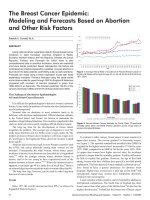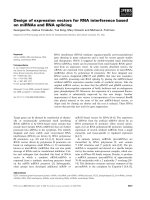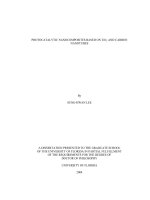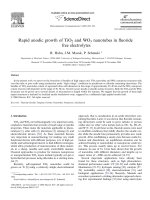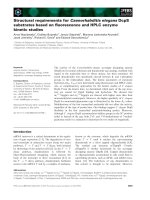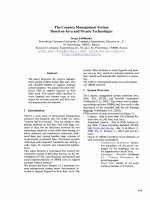- Trang chủ >>
- Khoa Học Tự Nhiên >>
- Vật lý
photocatalytic nanocomposites based on tio2 and carbon nanotubes
Bạn đang xem bản rút gọn của tài liệu. Xem và tải ngay bản đầy đủ của tài liệu tại đây (4.53 MB, 107 trang )
PHOTOCATALYTIC NANOCOMPOSITES BASED ON TiO
2
AND CARBON
NANOTUBES
By
SUNG-HWAN LEE
A DISSERTATION PRESENTED TO THE GRADUATE SCHOOL
OF THE UNIVERSITY OF FLORIDA IN PARTIAL FULFILLMENT
OF THE REQUIREMENTS FOR THE DEGREE OF
DOCTOR OF PHILOSOPHY
UNIVERSITY OF FLORIDA
2004
Copyright 2004
by
SUNG-HWAN LEE
This document is dedicated to my wife, and daughter with love.
iv
ACKNOWLEDGMENTS
I would like to sincerely thank Dr. Wolfgang Sigmund for serving as my adviser
and giving me the opportunity to perform this research. Additionally I would like to
acknowledge and thank Drs. Brij Moudgil and Ben Koopman for giving me advice on
many occasions and their fruitful conversations. Many of the achievements during my
doctoral research would not have been possible without their excellent guidance and
support. I also would like to acknowledge the Particle Engineering Research Center
(PERC) for the financial support.
I would like to thank Drs. Dinesh Shah, Ellsworth Whitney, Susan Sinnott, Darryl
Butt for serving as my advisory committee.
I would like to thank PERC graduate students, Georgios, Smithi, and Vijay who
have collaborated on diverse experiments. Cagri is appreciated for the operation of
atomic force microscope (AFM). I am grateful to Peter for the experimental support in
electrospinning.
Last, but not least, I wish to offer my sincere thanks to my parents, wife and
daughter who encouraged me whenever I felt exhausted. I especially thank my wife, Im-
Young, for being with me.
v
TABLE OF CONTENTS
page
ACKNOWLEDGMENTS iv
LIST OF TABLES vii
LIST OF FIGURES viii
ABSTRACT xi
1 INTRODUCTION 1
Titanium Dioxide (TiO
2
) Photocatalysis 3
Photocatalytic Disinfection of Biological Contaminants 8
Design and Synthesis of Highly Enhanced Photocatalyst System 13
Design of TiO
2
-Carbon Nanotube System 13
TiO
2
Nanocoating on Carbon Nanotubes 19
Electrospinning of Photocatalytic Nanofibers 21
2 EXPERIMENTAL AND METHODOLOGY 25
Experimental Parameters in Photocatalytic Efficiency Tests 25
Preparation of Photocatalytic Nanocomposite Particulate 28
TiO
2
Nanocoated Carbon Nanotubes 28
Benchmark: Degussa Aeroxide
®
P25 32
Dye Degradation Test 33
Spore Inactivation Test 37
Electrospun Photocatalytic Nanofibers 41
3 RESULTS AND DISCUSSION 45
Material Characterization 45
TiO
2
Nanocoated Carbon Nanotubes 45
Characterization of Electrospun Photocatalytic Nanofibers 53
Dye Degradation Test 60
Photocatalysis with UV-A Irradiation 63
Photocatalysis with Visible Light and Post UV-A Reaction 67
Spore Inactivation Test under UV-A irradiation 70
vi
Young’s Modulus of Electrospun TiO
2
-Carbon Nanotube composite fibers 73
4 CONCLUSIONS 80
LIST OF REFERENCES 83
BIOGRAPHICAL SKETCH 95
vii
LIST OF TABLES
Table
page
1-1. Bandgap energy of various photocatalysts 4
1-2. Primary process and characteristic time of TiO
2
photocatalysis in H
2
O 8
1-3. Modes of microorganism removal or inactivation action for various disinfection
methods 12
1-4. Work functions of noble metals and carbon materials 19
3-1. Diameters, suspended lengths, and Young’s moduli of nanofibers 77
viii
LIST OF FIGURES
Figure
page
1-1. Schematic diagram; overall process of semiconductor photocatalysis in an aqueous
system 7
1-2. Schematic diagram; photogeneration of charge carriers in TiO
2
and electron
trapping by fullerene (reduction of C
60
) 16
1-3. Schematic diagram; photogeneration of charge carriers in a TiO
2
shell and electron
trapping by a carbon nanotube core and following reactions where CNT is a carbon
nanotube, h
VB
is a hole in TiO
2
valence band, e
CB
is a electron in TiO
2
conduction
band, and e
t
is trapped electrons 18
2-1. Influence of the different experimental parameters which govern the reaction rate r;
(a) amount of catalyst, (b) wavelength, (c) temperature, and (d) radiant flux [101]27
2-2. ζ potential of as received and functionalized carbon nanotubes vs. pH 30
2-3. Flow chart of TiO
2
sol-gel nanocoating on carbon nanotubes 31
2-4. Molecular structure of azo dye (Procion Red MX-5B) 34
2-5. Experimental setup for photocatalytic dye degradation 35
2-6. Dye degradation by photocatalytic reaction; absorption intensity decrease in UV-Vis
spectra because of photodegradation by Degussa Aeroxide
®
P25 36
2-7. SEM image of (a) endospores and (b) bacteria, and (c) structure of endospore: core;
cellular components, DNA, UV resistance, cortex; heat resistance, peptidoglycan,
~200 nm, inner spore coat: acid resistant proteins, 20-40 nm, outer spore coat;
alkali resistant proteins, 40-90 nm 38
2-8. Experimental setup for spore inactivation test 41
2-9. Flowchart of electrospinning of photocatalytic nanofibers 43
2-10. Schematic diagram of electrospinning 44
2-11. Schematic diagram of AFM three point bending test on electrospun polycrystalline
nanofiber 44
ix
3-1. TEM images of surface functionalized multi-walled carbon nanotube 46
3-2. SEM images (a) anatase nanocoated carbon nanotubes and (b) anatase coating
fragments after carbon nanotube burn-out, and (c) TGA/DTA analysis 48
3-3. XRD pattern of anatase nanocoating fragments after carbon nanotube removal 49
3-4. XRD pattern of rutile nanocoating fragments after carbon nanotube removal 49
3-5. TEM images of (a), (b) individual, (c) agglomerated anatase nanocoated carbon
nanotubes, and (d) SAD pattern 50
3-6. TEM images of (a), (b) individual, (c) agglomerated rutile nanocoated carbon
nanotubes, and (d) SAD pattern 51
3-7. FTIR spectra of anatase nanocoated carbon nanotubes (a) before heat treatment, (b)
after heat treatment (500°C, 3 hours), and (c) anatase coating layer (carbon
nanotubes removed by thermal oxidation at 750°C) 52
3-8. XRD patterns (a) TiO
2
nanofibers and (b) TiO
2
-Ag nanofibers 55
3-9. Electron microscopy images of PVP-TiO
2
continuous nanofibers (a-c) SEM and (d)
TEM 56
3-10. Electron microscopy images of TiO2 continuous nanofibers (a-c) SEM and (d)
TEM 57
3-11. Electron microscopy images and XRD pattern of TiO
2
-carbon nanotube continuous
composite nanofibers (a) SEM, (b) TEM, and (c) XRD 58
3-12. Electron microscopy images and EDS spectra of TiO2-Ag continuous composite
nanofibers (a, b) SEM, (c) TEM image, and (d) EDS 59
3-13. UV-Vis spectra of (a) anatase nanocoated carbon nanotubes and (b) Degussa
Aeroxide
®
P25 dispersed in the dye solution without irradiation 61
3-14. Dye degradation by anatase – carbon nanotube mixture as a function of carbon
nanotube amount 62
3-15. Direct comparison of dye degradations by anatase nanocoated carbon nanotubes,
rutile nanocoated carbon nanotubes and Degussa Aeroxide
®
P25 with UV-A
irradiation 64
3-16. Curve fitting (the first order of exponential decay) and extrapolation of dye
degradation data by anatase nanocoated carbon nanotubes and Degussa Aeroxide
®
P25 with UV-A irradiation 65
x
3-17. Schematic band diagrams and charge carrier separation mechanisms of (a) hole
trapping in Degussa Aeroxide
®
P25 and (b) electron trapping in anatase nanocoated
carbon nanotubes 66
3-18. Photocatalytic dye degradation by anatase nanocoated carbon nanotubes with
visible light irradiation 68
3-19. Post UV-A dye degradation by anatase nanocoated carbon nanotubes 69
3-20. Photocatalytic endospore inactivation by anatase nanocoated carbon nanotubes and
Degussa Aeroxide
®
P25 with UV-A irradiation 72
3-21. Curve fitting (the first order of exponential decay) and extrapolation of spore
inactivation data by anatase nanocoated carbon nanotubes and Degussa Aeroxide
®
P25 with UV-A irradiation 72
3-22. Images of sample nanofibers (a) SEM image of nanofiber deposited on alumina
membrane, (b) AFM image of nanofiber on alumina membrane, (c) TEM image of
polycrystalline TiO
2
electrospun fibers, and (d) TEM image of TiO
2
-carbon
nanotube composite fibers 74
3-23. Actual AFM scanning data on (a) fiber and (b) pore; force (F) is applied at the
middle of the fiber lying on a pore with a diameter (L) for three point bending 75
3-24. Actual AFM force curves of alumina substrate, Si wafer, and TiO
2
nanofiber 76
3-25. Young’s Modulus vs. diameter of TiO
2
and TiO
2
-carbon nanotube fibers 79
xi
Abstract of Dissertation Presented to the Graduate School
of the University of Florida in Partial Fulfillment of the
Requirements for the Degree of Doctor of Philosophy
PHOTOCATALYTIC NANOCOMPOSITES BASED ON TiO
2
AND CARBON
NANOTUBES
By
Sung-Hwan Lee
December, 2004
Chair: Wolfgang M. Sigmund
Major Department: Materials Science and Engineering
Nanocomposite particles and fibers based on TiO
2
and multi-walled carbon
nanotubes were developed for photocatalytic applications, such as purification of organic
contaminants and disinfection of hazardous microorganisms. TiO
2
(either anatase or
rutile) nanocoated carbon nanotubes were synthesized via sol-gel. Their nanostructures
were characterized with HRTEM, SAD, and XRD. The anatase nanocoated carbon
nanotubes had 172 m
2
/g BET specific surface area (SSA) which was more than three
times larger than the best photocatalytic nanoparticles in market (Degussa Aeroxide
®
P25, SSA 50 m
2
/g). The anatase nanocoated carbon nanotubes showed higher
photodegradation of dye molecules than Degussa Aeroxide
®
P25 under UV-A irradiation.
In addition, the anatase nanocoated carbon nanotubes were reactive with visible light
irradiation and, consequently, dye degradation was observed with visible light while
Degussa Aeroxide
®
P25 was not effective. Any significant sign of photocatalysis was not
observed when rutile nanocoated carbon nanotube was used. Effective inactivation of
xii
bacterial endospores (Bacillus Cereus) in an aqueous medium was achieved with anatase
nanocoated carbon nanotubes with UV-A irradiation. The inactivation with Degussa
Aeroxide
®
P25 was slower in the same experimental condition. The rutile nanocoated
carbon nanotube was not considerably functioning in dye degradation and spore
inactivation.
A few obstacles still remain for production and practical applications of the anatase
nanocoated carbon nanotubes; (a) low yield from the sol-gel process and (b) limited use
as a particulate system because of potential toxicity of particles. These problems were
overcome by electrospinning. Anatase, anatase-silver, and anatase-carbon nanotubes
continuous nanofibers were produced successfully. For photocatalytic filtration
applications, it was important to understand the mechanical properties of the
photocatalytic nanofibers because of the brittle nature of ceramic materials. Young’s
moduli (E) of electrospun fibers were determined by three point bending test using
atomic force microscopy (AFM). It was observed that polycrystalline anatase nanofiber
had lower E than bulk. Moreover, the mechanical reinforcement by carbon nanotubes was
observed in the anatase-carbon nanotube composite nanofibers.
1
CHAPTER 1
INTRODUCTION
The purpose of this study was to develop novel photocatalytic systems to provide
for the solution of more than 99% clean up of organic and biological contaminants that
impact the health and safety of the civilian, commercial, and defense sectors. Since the
1970s, scientists began to realize that the susceptibility of titanium dioxide (TiO
2
) to
absorb photon energy from the UV end of the solar spectrum and then react with water
molecules to produce radicals could be used to create surfaces that were, for all practical
purposes, self-cleaning. Photocatalysts can break down almost any organic compound,
and a number of research groups have been seeking to take advantage of its reactivity by
developing a wide range of environmentally beneficial products [1-3]. Not only organic
contaminants can be destroyed by TiO
2
particles but also microorganisms can be
inactivated. When a microorganism is in contact with the TiO
2
surface that is exposed to
UV light of a wavelength below 385 nm, hydroxyl radicals are formed and break down
the cell wall and outer membrane, allowing cell contents to leak out and TiO
2
particles to
enter, thereby causing cell damage and death in the presence of water [4]. One of the
largest fields of interest and growth in the upcoming century is that of photocatalysis.
From October 15-17, 2003, the International Photocatalysis Technology Convention and
Exhibition was held in Tokyo, Japan. There it was predicted that by 2005 the market of
photocatalysis for the environment will reach 10 billion dollars. The concept of
benefiting mankind in a helpful manner has great moral and ethical worth.
2
Highly efficient TiO
2
photocatalytic particulate and continuous fibrous systems
were developed by modifying the TiO
2
electronic structure and increasing reactive
surface area of the catalysts with multi-walled carbon nanotubes in this study.
Nanotechnology (photocatalyst design, synthesis and characterization) and environmental
engineering sciences (microbial evaluation) were assembled to improve conventional
water and air purification systems. The novelty of the approach was in the integration of
the most reactive photocatalyst, TiO
2
, with carbon nanotubes that can provide high
surface area and excessive quantum yield because of their high aspect ratio and charge
carrier scavenging. Both the nanoparticulate system (TiO
2
nanocoated carbon nanotubes)
and the continuous nanofiber system (electrospun photocatalytic nanofibers) were
successfully developed and diverse properties were determined.
Specific objectives were as follows:
1. The design of photocatalytic nanocomposite systems which have higher
photocatalytic efficiency (both surface properties and quantum yield) than the best
commercial photocatalyst (Degussa Aeroxide
®
P25) with UV-A (wavelength of
350 nm), or visible light irradiation.
2. The synthesis and the characterization of nanostructured photocatalytic
nanocomposites.
3. The determination of photocatalytic efficiencies in organic dye degradation and
spore inactivation using Degussa Aeroxide
®
P25 as a standard. It has been well
established how to determine the dye degradation efficiency of photocatalysts of
Degussa Aeroxide
®
P25. However, it was challenging to inactivate spores because
of their multi-protective layers and there has not been a published work of spore
inactivation of Degussa Aeroxide
®
P25. The water-borne spore inactivation tests
were attempted and the efficiency of each photocatalyst is measured.
4. The preparation of continuous photocatalytic (composite) nanofiber to overcome
the potential toxicity of the nanoparticulate system and the determination of the
mechanical property (Young’s Modulus) by atomic force microscopy (AFM) three
point bending.
3
Titanium Dioxide (TiO
2
) Photocatalysis
TiO
2
is a ubiquitous opaque white pigment. This stable filler and colorant has been
widely used to make products as diverse as paper, plastics, lipstick, toothpaste, and
pharmaceutical tablets [5]. Moreover, TiO
2
nanoparticles in the 10-50 nm range take on
unusual properties and can be used in various applications, such as self-cleaning window
glass, air and water purification systems, and antibacterial coating by tapping the
photocatalytic properties of these particles. Scientists have adapted them to remove
nitrogen oxides from power plant exhausts, and they are looking at ways to harness these
environmental catalysts to treat diesel vehicle emissions. TiO
2
is a wide bandgap
semiconductor and researchers are looking at it as a substitute for silicon to make solar
power cells, as well as battery storage media [6].
According to IUPAC (International Union of Pure and Applied Chemistry)
compendium of chemical terminology, photocatalysis is defined as a catalytic reaction
involving light absorption by a catalyst or by a substrate [7]. In 1972, Fujishima and
Honda discovered the photocatalytic splitting of water on TiO
2
electrodes [8]. Since then,
research efforts in understanding the fundamental processes and in enhancing the
photocatalytic efficiency of TiO
2
have come from extensive research performed by
scientists. In recent years, environmental cleanup applications have been one of the most
active areas in heterogeneous photocatalysis. This is inspired by the potential application
of TiO
2
-based photocatalysts for the total destruction of organic compounds in polluted
air and wastewaters [9,10]. There are semiconductors which can be used for
photocatalysis, such as WO
3
, Fe
2
O
3
, CeO
2
, ZnO
2
and ZnS [11]. Metal sulfides are not
stable enough for catalysis in aqueous media due to photoanodic corrosion and they are
also toxic. Fe oxides undergo photocathodic corrosion. ZnO is unstable in water and
4
forms Zn(OH)
2
on the particle surface [12]. In this study, the most important purpose is
the modification and utilization of TiO
2
for an advanced photocatalysis. Thus, complete
understanding of the fundamental nature of TiO
2
for photoelectric and photochemical
properties is necessary before modification. The properties are related to the atomic
structure. TiO
2
crystallizes in three major different structures: rutile (tetragonal
/mnmP4D
2
14
4h
− , a = b = 4.584 Å, c = 2.953 Å), anatase (tetragonal, /amdP4D
1
19
4h
− , a
= b = 3.782 Å, c = 9.502 Å) and brookite (rhombohedrical, PbcaD
15
2h
− , a = 5.436 Å, b =
9.166 Å, c = 5.135 Å) [13]. Only rutile and anatase play any role in the applications and
are of interest here. Photocatalysis is attributed to the electrical characteristics of TiO
2
.
The band gap energy of rutile is 3.0 eV and that of anatase is 3.2 eV. The electron
effective masses (m
*
) in rutile and anatase are approximately 20 m
0
and 1 m
0
, respectively
(m
0
is electron rest mass). The mobility of the electrons in rutile is about 89 times lower
than that in anatase according to µ ∝ (m
*
)
-3/2
T
1/2
for polar semiconductors. The
diffusivity of the electrons in rutile is also ~89 times smaller than in anatase [14].
Table 1-1. Bandgap energy of various photocatalysts
Photocatalyst Bandgap energy (eV) Photocatalyst Bandgap Energy (eV)
Si 1.1 ZnO 3.2
TiO
2
(rutile) 3.0 TiO
2
(anatase) 3.2
WO
3
2.7 CdS 2.4
ZnS 3.7 SrTiO
3
3.4
SnO
2
3.5 WSe
2
1.2
Fe
2
O
3
2.2
α-Fe
2
O
3
3.1
The wide band-gap semiconductors can act as sensitizers for light-induced redox
processes due to their electronic structure, which is characterized by a filled valence band
and an empty conduction band. When a photon with energy of h
ν
matches or exceeds the
5
bandgap energy of the semiconductor, an electron is excited from the valence band into
the conduction band leaving a hole behind. Excited state conduction-band electrons and
valence-band holes can recombine and dissipate as heat. The valence-band holes are
powerful oxidants, while the conduction-band electrons are good reductants. For organic
compound degradation the redox potential of H
2
O/OH
•
must be within the bandgap of the
semiconductor. When the aqueous solution of the semiconductor photocatalyst is excited
with ultraviolet light, electron-hole pairs develop. These electron-hole pairs have an
oxidizing potential of 2.9 V vs. normal hydrogen electrode (NHE), which is enough to
oxidize most pollutants. The general TiO
2
photocatalytic reactions can be described by
the equations 1-1 and 1-2. The most important reaction involves hydroxyl ions (OH
-
) on
the surface of TiO
2
reacting with the holes, forming hydroxyl radicals (OH
•
), which is the
main cause of the photodegradation of organic contaminants and the inactivation of
hazardous microorganisms [12,15].
TiO
2
+ h
ν
→ e
cb
-
+ h
vb
+
(1-1)
h
vb
+
+ Ti⋯OH → Ti⋯OH
•
(1-2)
In the absence of suitable electron and/or hole scavengers, the stored energy is
dissipated within a few nanoseconds by recombination. Recombination of the
photoexcited electron-hole pair needs to be retarded for an efficient charge transfer
process to occur on the photocatalyst surface. The efficiency of the photocatalytic process
can be measured as a quantum yield, which is defined as the number of defined events
occurring per photon absorbed by the system or as the amount (mol) of reactant
6
consumed or product formed per amount of photons (Einstein) absorbed [7]. The ability
to measure the actual absorbed light is practically not feasible in heterogeneous systems
due to scattering of light by the semiconductor surface and the recombination. It is
usually assumed that all the light is absorbed and the capacity is quoted as an apparent
quantum yield. If several products are formed from the photocatalytic reaction, then the
efficiency is sometimes measured as the yield of a particular product. The quantum yield
for an ideal system (
φ
) can be given by the simple relationship [15]:
RCT
CT
kk
k
+
∝
φ
(1-3)
where k
CT
is the charge transfer process rate and k
R
is the electron-hole recombination
rate
Assuming that diffusion of the products occurs quickly without the reverse
reaction,
φ
is proportional to the rate of the charge transfer processes and inversely
proportional to the sum of the charge transfer rate and the electron-hole recombination
rate. Without recombination the quantum yield would take on the ideal value of 1 for the
photocatalytic process. Charge carrier trapping would suppress recombination and
increase the lifetime of the separated electron and hole. Surface and bulk defects naturally
occur during the synthesis and they may help suppress the recombination by trapping
charge carriers. The hole produced by irradiation reacts with water or surface-bound
hydroxyl ion producing hydroxyl radical. Electron released by irradiation of
photocatalyst combines with dissolved molecular oxygen, producing the superoxide
radical, O
2
•
. Hydrogen peroxide possibly added acts as an oxidant, but also as an e
-
7
scavenger instead of dissolved molecular oxygen. H
2
O
2
•
dissociates to hydroxyl radical
and hydroxide ion even easier than H
2
O
2
, due to an extra electron [12-16]. Primary
process and characteristic time of TiO
2
photocatalysis in an aqueous system is listed in
Table 1-2 [16].
The photocatalyst can be used for the photodegradation of organic molecules
denotes the conversion of organic compounds to CO
2
, H
2
O, NO
3
-
, or other oxides, halide
ion, phosphate, etc. for environmental remediation. Often degradation begins with partial
oxidation, and mechanistic studies relevant to oxidative photocatalytic degradation
frequently focus on early stages involving photooxygenation, photooxidative cleavages,
or other oxidative conversions. Environmental decontamination by photocatalysis can be
more appealing than conventional chemical oxidation methods because semiconductors
are inexpensive, nontoxic, and capable of extended use without substantial loss of
photocatalytic activity.
Figure 1-1. Schematic diagram; overall process of semiconductor photocatalysis in an
aqueous system
Conduction Band
Valence Band
h
ν
h
+
e
-
O
2
O
2
TiOH
•
TiOH
8
Table 1-2. Primary process and characteristic time of TiO
2
photocatalysis in H
2
O
Primary Process Characteristic time (second)
Charge-carrier generation
−+
+⎯→⎯
CBVB2
ehTiO
hv
10
-15
(very fast)
OH
•+
formation at the TiO
2
surface
+•+
>→>+ }OHTi{OHTih
IVIV
VB
10
-9
(fast)
Electron trapping
OH}Ti{OHTie
IIIIV
CB
>↔>+
−
IIIIV
CB
TiTie ↔>>+
−
10
-10
(shallow trap; dynamic
equilibrium)
10
-8
(deep trap; irreversible)
Charge-carrier recombination
OHTi}OHTi{e
IVIV
CB
→>>+
+•−
OHTiOH}Ti{h
IVIII
VB
→>>+
+
10
-7
(slow)
10
-9
(fast)
Interfacial charge transfer
+•+•
+→>+> RedOHTiRed}OHTi{
IVIV
−•−
+→>+
x
IV
xt
OOHTiOe
10
-7
(slow)
10
-3
(very slow)
Photocatalytic Disinfection of Biological Contaminants
Bioweaponry has its roots from the ancient past and became a science in the early
20
th
century following the breakthrough discoveries in microbiology and immunology of
the late 1800s. Direction of bioweapons against the military is biowarfare and direction
against civilians is bioterrorism [17]. The biological warfare agent was first used during
the French and Indian Wars by British forces in North America (1754-1767) [18]. Since
the anthrax epidemic caused by the escape of an aerosol of
Bacillus anthracis (anthrax) at
the military facility in Union of Soviet Socialist Republics in 1979 [19] and by the
anthrax mail
via US Postal Service in the United States in 2001 [20]. The non-natural
epidemic by biological warfare agents has been great concern over the entire society [21].
It costs more than $ 100 million to clear anthrax out an contaminated building
(Brentwood post office, Washington D.C. and American Media building, Boca Raton,
9
Florida) and there are immediate needs to develop a highly efficient method for clean-up
of biologically contaminated area [22].
The concern over chemical and biological warfare agents, such as anthrax, has been
greatly increased since the terrorist attack in the U.S. on September 11
th
2001. Bacillus
anthracis
, the bacterium that causes anthrax, emerged as one of the most threatening
biological agents that may be used as weapons. Anthrax spores were mailed to several
locations
via the US Postal Service resulting in twenty-two confirmed or suspected cases
of anthrax infection [23]. The photocatalytic destruction of warfare agents, nerve agent
stimulant (organophosphorus compounds) and mustard gas stimulant (organosulfur
compounds), has been studied in the past decade [24-28]. The chemical compounds can
be completely mineralized via multiple steps involving several intermediate products. In
most cases, CO
2
, H
2
O, and inorganic salts are the final products and no hazardous final
byproducts are formed. However, photocatalytic oxidation over TiO
2
can be kinetically
retarded due to the accumulation of partially oxidized intermediate species on the catalyst
surface, a poisoning process which can occur rapidly in some cases if the photocatalytic
removal rate is not high enough [29]. Since the 1980s, antimicrobial treatment has
become a prevalent and widely accepted remediation strategy to control harmful
organisms [30-36]. While contributing to the health and safety of the public and the
preservation of materials by decreasing the number of microorganisms, antimicrobial
pesticides involve risks of silent failure, causing potential exposure hazards. Biological
warfare agents include bacteria, viruses, fungi, and other living microorganisms that can
kill or incapacitate. Bacterial diseases are considered the most likely avenue of attack,
because bacteria can be easily produced in fermenters, the infectious organisms can be
10
easily spread through air or water, and the diseases have a short incubation time and high
lethality. In this study, photocatalytic nanocomposite systems, which are composed of
TiO
2
shell and carbon nanotube core, are developed to destroy microorganisms and
toxins in the environment as well as chemical agents. Photocatalytic technology of TiO
2
is an attractive approach for controlling environmental pollutants because of the
following characteristics:
•
TiO
2
is an environmentally benign material
•
The same basic technology can be applied to both water and air media
•
The use of a catalyst eliminates the need for chemical oxidants
•
Microbes are completely mineralized
•
High destruction rates enable the system to be compact
•
Either black lights or solar energy can serve as the excitation source
•
The scientific basis of the technology has already been established
The greatest bacterial threats may be anthrax (caused by
Bacillus anthracis), plague
(caused by
Yersinia pestis), and Tularemia (caused by Francisella tularensis). Spores of
Bacillus anthracis are particularly dangerous because they are stable for years or decades
in the environment [37]. Anthrax is transmitted through inhalation, contact with skin,
and ingestion. Importantly, antibiotics can treat bacterial diseases. The U.S. government
is taking steps to ensure that adequate supplies of antibiotics are available and can
quickly be transported to combat disease outbreaks. Viral diseases might be considered a
less likely bioterrorism agent because pathogenic viruses can only reproduce inside host
cells and thus require sophisticated tissue culture techniques for mass production.
However, antibiotics are not effective against viruses and vaccines are not available for
most severe viral diseases. Among these are the viral hemorrhagic fevers (VHFs) that
include Ebola, Marburg, Lassa, and South American VHF viruses. VHFs can result from
11
the inhalation of aerosolized virus. Case fatality rates for Ebola and Marburg are 25-88%
according to Centers for Disease Control and Prevention (CDC).
Gerba and coworkers reported that the rapid emergence of waterborne pathogens,
such as
Cryptosporidium parvum and Escherichia coli O157:H7, have created a threat to
the drinking water industry and there is a growing need to develop a strategy [38]. He
also claimed that toilet seats could be cleaner than kitchen and office areas. For example,
work stations contain nearly four hundred times as many microbes than lavatories. Thus,
the surfaces must be regularly disinfected to prevent the spread of viruses and bacteria
responsible for disease. If photocatalysts, which are reactive under sunlight or room light
are available and surfaces are coated with those, infected surfaces can be self-cleaned.
Because of the widespread use of antibiotics and the emergence of more resistant
and virulent strains of microorganisms, there is an immediate need to develop alternative
sterilization technologies [33]. Although a wealth of information has demonstrated the
efficacy of the biocidal actions of the TiO
2
photocatalyst, the fundamental mechanism
underlying the photocatalytic inactivation of microorganism has not yet been well
established. In 1985, Matsunaga and coworkers reported that microbial cells in water
could be killed by contact with a TiO
2
-Pt catalyst upon illumination with near-UV light
for 60 to 120 min [30]. Later, the same group of workers successfully constructed a
practical photochemical device in which TiO
2
powder was immobilized on an acetyl
cellulose membrane. An
Escherichia coli O157:H7 suspension flowing through the
device was completely sterilized [39]. They observed that the extent of killing was
inversely proportional to the thickness and structure of the cell wall. Their findings
occupied the attention for sterilization and resulted in attempts to use this technology for
12
disinfecting drinking water and removing bioaerosols from indoor air environments [31-
36]. When irradiated TiO
2
particles are in direct contact with or close to microbes, the
microbial surface is the primary target of the initial oxidative attack of OH
•
generated by
the TiO
2
photocatalyst. Polyunsaturated phospholipids are an integral component of the
bacterial cell membrane, and many functions, such as semipermeability, respiration, and
oxidative phosphorylation reactions, rely on an intact membrane structure. Therefore,
lipid peroxidation is detrimental to all forms of life. The TiO
2
photocatalytic reaction
indeed causes the lipid peroxidation reaction to take place and normal functions
associated with an intact membrane are lost. The loss of membrane structure and
membrane functions is the root cause of cell death when photocatalytic TiO
2
particles are
outside the cell [33]. Secondary wastewater effluent containing 10
3
to 10
6
CFU/ml of
bacteria and viruses was treated through TiO
2
photocatalysis under sunlight or simulated
sunlight and two-log inactivation, which is similar to the disinfection rates obtained by
Matsunaga
et al. was observed. Fungi, tumor cells and even cancer cells have been
successfully inactivated by TiO
2
photocatalysis as well [31]. The disinfection actions of
various methods are summarized in Table 1-3 [4].
Table 1-3. Modes of microorganism removal or inactivation action for various
disinfection methods
Method
OH
•
O
2
-
, H
2
O
2
Cl
hv
Adsorption Capture
Photocatalysis
√ √
√
†
√
√
‡
UV (254nm)
√
Chlorine
√
HEPA filter
√
†
UV-A irradiation may have some inactivation effect on sensitive organisms
‡
In some catalyst configurations, photocatalyst may act as a filter
13
Design and Synthesis of Highly Enhanced Photocatalyst System
Design of TiO
2
-Carbon Nanotube System
One of the very basic results of the physics and chemistry of solids is the insight
that most properties of solids depend on the microstructure,
i.e. the chemical
composition, the arrangement of the atoms (atomic structure) and the size of a solid in
one, two or three dimensions. If one of these parameters is changed, the properties of a
solid change accordingly. The synthesis of novel materials with new properties by means
of the controlled manipulation of their microstructure on the atomic level has become an
emerging interdisciplinary field based on solid state physics, chemistry, biology and
materials science. Novel materials may involve (isolated, substrate-supported or
embedded) nanometer-sized particles, thin wires or thin films with reduced dimensions
and/or dimensionality. Size effects result if the characteristic size of the building blocks
of the microstructure is reduced to the point where critical length scales of physical
phenomena (
e.g. the mean free paths of electrons or phonons, a coherency length, a
screening length,
etc.) become comparable with the characteristic size of the building
blocks of the microstructure [40,41]. The size effect on photocatalytic applications is still
controversial. The relationship between the TiO
2
particle size and photocatalytic activity
has been addressed and the significant disagreements require a careful approach. Anpo
et
al. reported an increase in the TiO
2
photocatalytic activity for the hydrogenation of
CH
3
CCH with decreasing particle size [42]. They associated the pronounced activity
enhancement for particles smaller than 10 nm with the combined effects of larger surface
area and size quantization. A similar observation was also made for the photocatalytic
degradation of methylene blue in aqueous suspension for a series of TiO
2
particles larger
than 30 nm. However, other reports showed that the photocatalytic efficiency does not

